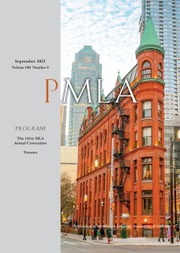No CrossRef data available.
Article contents
Three Documents from the Archive of Roma Enslavement
Published online by Cambridge University Press: 06 January 2025
Abstract
An abstract is not available for this content so a preview has been provided. Please use the Get access link above for information on how to access this content.

- Type
- Little-Known Documents
- Information
- Copyright
- Copyright © 2024 The Author(s). Published by Cambridge University Press on behalf of Modern Language Association of America
References
Works Cited
Achim, Venera, and Tomi, Raluca, editors. Documente de arhivă privind robia țiganilor: Epoca dezrobirii. Romanian Academy Publishing, 2010.Google Scholar
Boatcă, Manuela. “Romani Europeans into Citizens.” Global Citizen Observatory, 2022, globalcit.eu/globalcit-review-symposium-of-the-fringes-of-citizenship-romani-minorities-in-europe-and-civic-marginalisation-by-julija-sardelic/4/.Google Scholar
Chang, Felix B., and Rucker-Chang, Sunnie T.. Roma Rights and Civil Rights: A Transatlantic Comparison. Cambridge UP, 2020.CrossRefGoogle Scholar
Chiriac, Bogdan. “Activitatea publicistică a lui Mihail Kogălniceanu în slujba cauzei aboliționiste din Moldova (1838–1856).” Culegeri de studii rome, edited by Furtună, Adrian-Nicolae, Editura Centrului National de Cultură a Romilor, 2022, pp. 55–96.Google Scholar
Doyle, Laura. Inter-imperiality: Vying Empires, Gendered Labor, and the Literary Arts of Alliance. Duke UP, 2020.Google Scholar
Furtună, Adrian-Nicolae. “Institutional Forms of Resistance during Slavery: The Case of Ioana Tinculeasa Rudăreasa.” Re-thinking Roma Resistance throughout History: Recounting Stories of Strength and Bravery, edited by Mirga-Kruszelnicka, Anna and Dunajeva, Jekatyerina, European Roma Institute for Arts and Culture, 2020, pp. 197–215.Google Scholar
Furtună, Adrian-Nicolae. Sclavia romilor în Țara Românească: Fragmente de istorie socială (Vânzări de copii/donații, căsătorii, cereri de dezrobire). National Center of Roma Culture, 2019.Google Scholar
Furtună, Adrian-Nicolae, and Turcitu, Claudiu Victor. Sclavia romilor și locurile memoriei: Album de istorie socială. Dykhta! Publishing House, 2021.Google Scholar
Hartman, Saidiya. Lose Your Mother: A Journey along the Atlantic Slave Route. Farrar, Straus and Giroux, 2008.Google Scholar
Matache, Margareta, and West, Cornel. “Roma and African Americans Share a Common Struggle.” The Guardian, 20 Feb. 2018, www.theguardian.com/commentisfree/2018/feb/20/roma-african-americans-common-struggle.Google Scholar
Mateescu, Bogdan. Căsătoria robilor: Între alegerea cuplului și voința stăpânului: Studiu și documente de arhivă despre căsătoriile robilor în Țara Românească după 1830. Etnous, 2014.Google Scholar
Meltzl, Hugo, editor. Jile Romane: Volkslieder der Transilvanisch-Ungarischen Zigeuner. Klausenburg, 1878.Google Scholar
Parvulescu, Anca, and Boatcă, Manuela. “The Longue Durée of Enslavement: Extracting Labor from Romani Music in Liviu Rebreanu's Ion.” Literature Compass, vol. 17, nos. 1–2, 2020, https://doi.org/10.1111/lic3.12559.CrossRefGoogle Scholar
Petcuț, Petre, editor. Rromii din România: Documente. Vol. 1, Romanian Institute for Research on National Minorities / Kriterion Publishing, 2009.Google Scholar
Potra, George. Contribuțiuni la istoricul țiganilor din România. Fundația Regele Carol I, 1939.Google Scholar
Rădulescu, Andrei, editor. Codul Calimach. Editura Academiei Republicii Populare Române, 1958.Google Scholar
Rădulescu, Andrei, editor. Legiuirea Caragea. Editura Academiei Republicii Populare Române, 1955.Google Scholar
Rădulescu, Andrei, editor. Sobornicescul Hristov. Editura Academiei Republicii Populare Române, 1958.Google Scholar
Szeman, Ioana. “‘Black and White Are One’: Anti-Amalgamation Laws, Roma Slaves, and the Romanian Nation on the Mid-Nineteenth-Century Moldavian Stage.” Uncle Tom's Cabins: The Transnational History of America's Most Mutable Book, edited by Davis, Tracy C. and Mihaylova, Stefka, U of Michigan P, 2020, pp. 165–91.Google Scholar
Tomi, Raluca. “Mişcarea aboliţionistă din principate și impactul ei asupra legislaţiei de dezrobire (1849–1856).” Revista Istorica, vol. 21, nos. 1–2, 2010, pp. 57–71.Google Scholar


